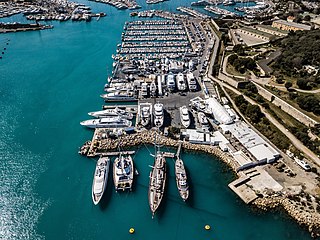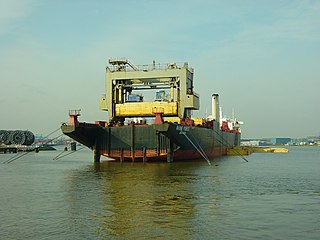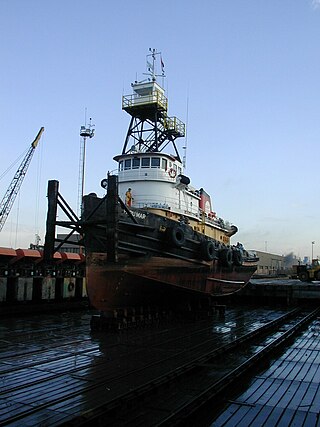Related Research Articles

The Philadelphia Naval Shipyard was the first United States Navy shipyard and was historically important for nearly two centuries.

A shipyard, also called a dockyard or boatyard, is a place where ships are built and repaired. These can be yachts, military vessels, cruise liners or other cargo or passenger ships. Compared to shipyards, which are sometimes more involved with original construction, dockyards are sometimes more linked with maintenance and basing activities. The terms are routinely used interchangeably, in part because the evolution of dockyards and shipyards has often caused them to change or merge roles.

A boat lift, ship lift, or lift lock is a machine for transporting boats between water at two different elevations, and is an alternative to the canal lock.

The Fairfield Shipbuilding and Engineering Company, Limited, was a Scottish shipbuilding company in the Govan area on the Clyde in Glasgow. Fairfields, as it is often known, was a major warship builder, turning out many vessels for the Royal Navy and other navies through the First World War and the Second World War. It also built many transatlantic liners, including record-breaking ships for the Cunard Line and Canadian Pacific, such as the Blue Riband-winning sisters RMS Campania and RMS Lucania. At the other end of the scale, Fairfields built fast cross-channel mail steamers and ferries for locations around the world. These included ships for the Bosporus crossing in Istanbul and some of the early ships used by Thomas Cook for developing tourism on the River Nile.

Tandanor is an Argentine shipyard located south of Buenos Aires port which together with Almirante Storni yard constitutes CINAR dedicated to shipbuilding and ship repair. It currently harbors ships from around the globe due to its international renown. Its competitive advantage springs from its Syncrolift: a shiplifting platform that allows vessels to be dry docked and perform simultaneous repairs on its six slipways. In April 2019, Tandanor signed a cooperation agreement with City Bank.

The lighter aboard ship (LASH) system refers to the practice of loading barges (lighters) aboard a bigger vessel for transport. It was developed in response to a need to transport lighters, a type of unpowered barge, between inland waterways separated by open seas. Lighters are typically towed or pushed around harbors, canals or rivers and cannot be relocated under their own power. The carrier ships are known variously as LASH carriers, barge carriers, kangaroo ships or lighter transport ships.

John Brown and Company of Clydebank was a Scottish marine engineering and shipbuilding firm. It built many notable and world-famous ships including RMS Lusitania, RMS Aquitania, HMS Hood, HMS Repulse, RMS Queen Mary, RMS Queen Elizabeth and Queen Elizabeth 2.

A shiplift is a modern alternative for a slipway, a floating dry dock or a graving dry dock. A shiplift is used to dry dock and launch ships. It consists of a structural platform that is lifted and lowered exactly vertically, synchronously by a number of hoists. First, the platform is lowered underwater, then the ship is floated above the support, and finally the platform with support and ship is lifted and the ship is brought to the level of the quay.

The Federal Shipbuilding and Drydock Company was a United States shipyard in New Jersey active from 1917 to 1948. It was founded during World War I to build ships for the United States Shipping Board. Unlike many shipyards, it remained active during the shipbuilding slump of the 1920s and early 1930s that followed the World War I boom years. During World War II, it built merchant ships as part of the U.S. Government's Emergency Shipbuilding program, at the same time producing more destroyers for the United States Navy than any yard other than the Bath Iron Works. Operated by a subsidiary of the United States Steel Corporation, the shipyard was located at Kearny Point where the mouth of the Hackensack River meets Newark Bay in the Port of New York and New Jersey.

The Rotterdamsche Droogdok Maatschappij (RDM) was the largest pre-World War II shipbuilding and repair company in Rotterdam in the Netherlands, existing from 1902 to 1996. It built 355 mostly major seagoing vessels, 18 of which were submarines. During its existence, the wharf operated 12 floating docks and in its heyday employed 7,000 people at one time.
The Elmer A. Sperry Award, named after the inventor and entrepreneur, is an American transportation engineering prize.

Devonshire Dock Hall is a large indoor shipbuilding and assembly complex that forms part of the BAE Systems shipyard in the Barrow Island area of Barrow-in-Furness, Cumbria, England.

Titan Clydebank, more commonly known as the Titan Crane is a 150-foot-high (46 m) cantilever crane at Clydebank, West Dunbartonshire, Scotland. It was designed to be used in the lifting of heavy equipment, such as engines and boilers, during the fitting-out of battleships and ocean liners at the John Brown & Company shipyard. It was also the world's first electrically powered cantilever crane, and the largest crane of its type at the time of its completion.

Syncrolift AS is a supplier of ship-handling equipment for shipyards. It manufactures the Syncrolift shiplift.
The Kattupalli Shipyard, officially Adani Katupalli Port Private Limited is a large shipyard project at Kattupalli village near Ennore in Chennai, being built by L&T Shipbuilding Ltd. It is being set up jointly by TIDCO and Larsen & Toubro (L&T) in two phases. L&T shipbuilding Kattupalli is a minor port. Adani ports and special economic zone (APSEZ) acquired Kattupalli Port from L&T in June 2018 and renamed it as Adani Katupalli Port Private Limited (AKPPL).

Israel Shipyards is a large shipbuilding and repair facilities in the eastern Mediterranean. The company also operates a privately owned port in Israel. The company's facilities are located at the Kishon Port.
Charleston Dry Dock & Machine Company was a shipyard located in Charleston, South Carolina, on the Cooper River. The shipyard is significant for its contribution to marine engineering, including the first entirely-welded commercial ship built in the United States. It was owned and operated by Leland Louis Green who was the first registered naval architect in South Carolina.

USS AFDM-2,, is an AFDM-3-class medium auxiliary floating drydock built in Mobile, Alabama by the Alabama Drydock and Shipbuilding Company for the U.S. Navy. Originally named USS YFD-4, Yard Floating Dock-4, she operated by Todd Shipyards at New Orleans, Louisiana for the repair of US ships during World War II. YFD-4 was renamed an Auxiliary Floating Dock Medium AFDM-2 in 1945 after the war.

Bethlehem Sabine Shipyard, or Sabine Shipyard was a 223-acre shipyard of Bethlehem Steel in Port Arthur, Texas. The Bethlehem Shipbuilding Corporation's Sabine Shipyard opened in August 1985. The yard serviced offshore drilling rigs and ships. The Sabine Shipyard had a nation's largest floating drydock. Bethlehem purchased the United States Navy surplus drydock, USS ABSD-5 that was at Pearl Harbor, Hawaii. USS ABSD-5 seven-sections were tugged to the Sabine Yard arriving in December 1984. USS ABSD-5 has a lift capacity of 64,000 tons.
References
- 1 2 "Sperry Awards - ASME" (PDF).
- 1 2 "Where is Today's Supersonic Jet?". The Atlantic . July 2015.
- ↑ "Raymond Pearlson" (PDF). Retrieved 13 November 2015.
- ↑ "Pearlson Shiplift: Our History". Pearson Shiplift. Retrieved 13 November 2015.